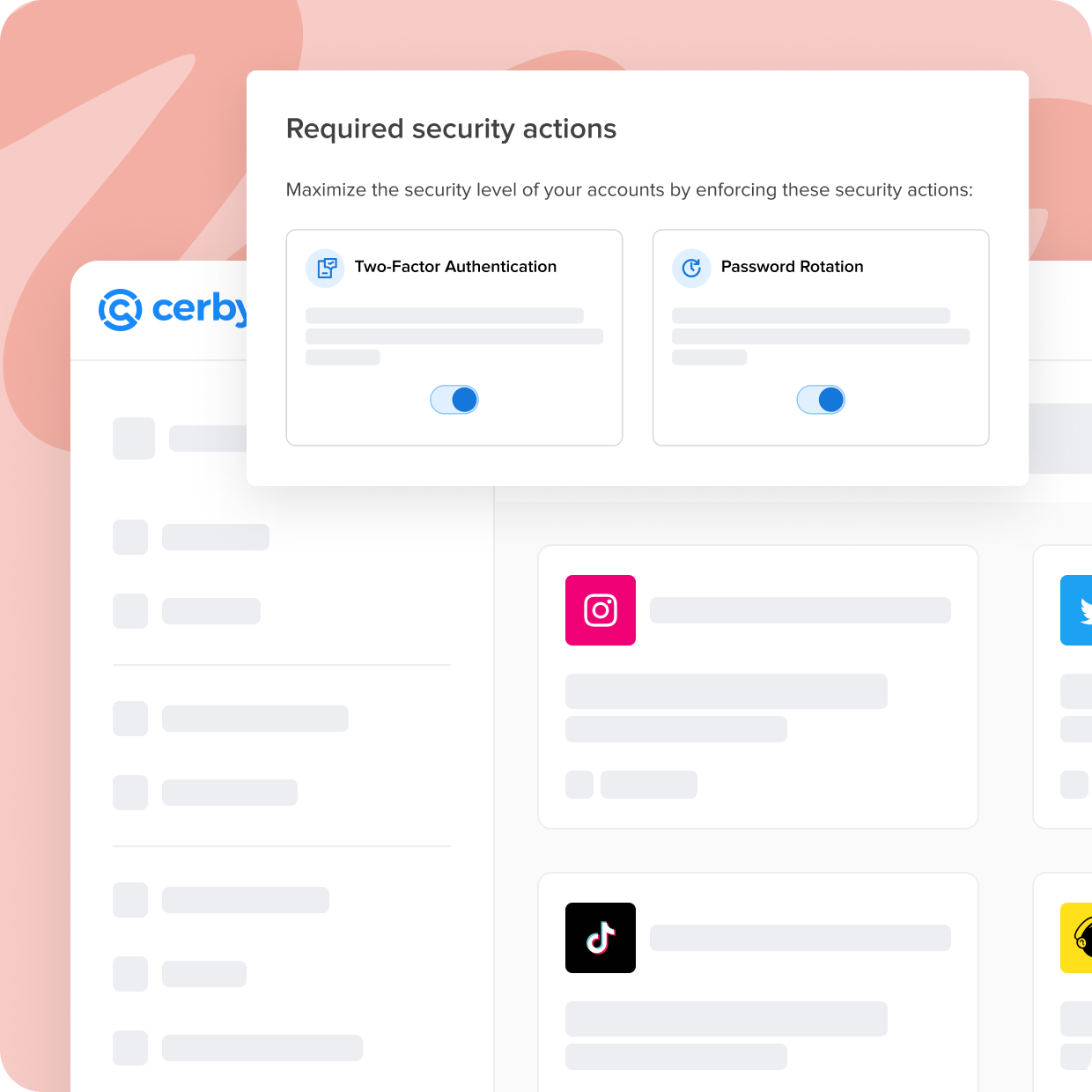Sharing logins is often necessary, but it can be risky. Why? When passwords for an account are shared, it typically means that two-factor authentication (2FA) is disabled. Unfortunately, many corporate applications don't support shared accounts. The applications that fall into this category are best called "unmanageable." Unmanageable applications are a new category that is becoming increasingly challenging for businesses to manage and secure effectively, yet increasingly critical for businesses to succeed.
Cerby allows you to securely share access to any application, even if it's not supported by your IT team. In this guide, you'll learn the best way to share passwords, the challenges, and the players.
Securely Share Access To Any Account
Not all apps are created equal. Some come with security gaps and complexities that can hinder user adoption and put sensitive data at risk. With Cerby, you can ensure secure and seamless access to all your applications.
With Cerby You Can

Get your team connected securely

Share logins without sharing passwords

Secure 3rd party access
Share Logins
In modern society, it seems as if there’s an account and password for everything – and not only that, but it’s becoming increasingly common for people to share logins with others. Sharing passwords and accounts happens for a wide variety of reasons – many of these reasons are born out of convenience, but some may also be necessities. Some people might share their Netflix account with family members, for instance, while others may share their work login credentials with colleagues in order to collaborate on a group project. However, this practice can lead to serious security risks and increase the likelihood of data breaches and identity theft.
While sharing login credentials may seem harmless, it can, unfortunately, have detrimental consequences. When multiple people have access to a single account, it becomes much more difficult to track who has logged in, when, where, and from what device. Additionally, even if just one person’s account is compromised, it can put everyone else who shares that account at risk.
In an effort to mitigate the risks posed by sharing accounts, many people rely on some form of password manager. Although password managers are a good way to share passwords, they are not without limitations.
In this article, we will discuss some advantages and disadvantages of sharing login credentials while delving into the best practices for using password managers to ensure optimum security. By fully understanding the risks associated with sharing login information, and by implementing effective password management strategies, users can better protect themselves and their information from potential cyber threats.
Password management system
Sharing login information with others may seem generous and/or convenient, but it can also come with numerous risks and unintended consequences. When you share your login information with someone else, you are basically granting that person access to all of the information associated with that account – including any contact or payment information that may be present and used for billing purposes. If the person sharing your login information is less than trustworthy, they might misuse or abuse your account and potentially cause serious harm to your financial security and reputation.
Another risk of sharing accounts or login credentials is privacy. If you share your login information with someone else, they might also gain access to your personal information (including your email address, home address, phone number, and other sensitive data). This can lead to unwanted spam, identity theft, or worse, as the person who has access to your login information could utilize it to access your other accounts and/or steal your identity.
Sharing logins can also result in unauthorized access to your account(s). If the person you’re sharing login credentials with is careless, they might accidentally leave your account logged in and accessible on a public computer, which would mean that anyone who came across it could access your personal information. And if you save your passwords on a shared device, other people who use that device might also have access to your saved passwords and your private information.
In an effort to address these risks, some people utilize a password management system that allows for the creation and secure storing of unique passwords for individual accounts. Most password management platforms have features like “my passwords”, “view saved passwords”, or “my saved passwords on this device” so users can have a better understanding of which passwords they’re using for which accounts, and on what devices they’re logged into.
Team Password Manager
In some cases, individuals might share passwords within and across companies in an effort to streamline collaborative initiatives. However, there are several reasons why businesses ought to implement more secure methods to reduce the risk of encountering a serious security threat.
One common solution is to simply share a password list or similar document via email or shared document. This is problematic for a number of reasons – if the document falls into the wrong hands, it can result in a major security breach. Furthermore, if an employee leaves the team or company, or their account has been compromised, they may still have access to the information on the list, which could lead to unauthorized access to sensitive information at best, and a full-fledged data breach at worst.
A study by the Ponemon Institute found that recent password manager breaches negatively impacted enterprise decisions to use them moving forward. Password managers apps such as LastPass, 1Password, and Dashlane offer secure password-sharing features that allow users to securely share passwords with family members, friends, and business associates. These password managers are fairly common but can pose a security risk if not utilized properly.
These password managers encrypt passwords and provide a secure way to share passwords without exposing the actual passwords to anyone. However, they cannot share 2FA codes, making it difficult to stay compliant with corporate policies and share passwords across teams and 3rd parties.
For these reasons and many others, businesses may find it is best to utilize a team password manager. The best company password manager will provide team members with the ability to securely store and share passwords without unnecessarily exposing that information to unauthorized users. Each team member can have their own unique login credentials, and access to specific passwords can be controlled and/or monitored by the team lead or administrator. This can enable easy collaboration and sharing of passwords without compromising security or personal information.
When choosing a team password manager, businesses must strive to implement a solution that utilizes strong encryption and multi-factor authentication to ensure optimum security. Additionally, a robust password manager must have other features like password sharing and delegation, which enable team members to share access to specific passwords without revealing the actual password itself. A solid team password manager will also provide detailed audit logs to track the users who have accessed each password, and a record of when the access took place.
Send Password Securely
There are a number of ways people can share passwords securely. One of the most popular options – using a digital password manager – generally allows users to store and share login information in a secure, encrypted database. Most password managers will also offer features like two-factor authentication and strong encryption to help ensure information is kept safe and secure. Some password managers are specially designed for team use, allowing users to share logins and users between multiple WordPress sites, or other platforms, for example.
Another popular password-sharing method is to utilize a one-time secret tool. These tools let users send passwords (or any other sensitive information) securely by creating a unique, one-time link that can be accessed only by the intended recipient. Once the recipient accesses the link, it is no longer valid, which effectively prevents unauthorized access.
And when businesses implement a secure password-sharing method, it can help streamline operations and enhance collaborative efforts and teamwork. When multiple users can access the same login information, team members can work more closely together and communicate more efficiently and effectively. This is especially useful in businesses that may have teams or personnel who work remotely, or across multiple locations.
By using a secure password-sharing platform, businesses and individuals alike can better protect sensitive information and prevent unauthorized parties from accessing private data. Password managers come in many different packages with various features and functionalities, and most offer strong encryption and two-factor authentication, which are crucial components of digital security. Additionally, many of these tools offer free login password management solutions, which makes them an ideal option for a diverse range of users with varying budgets and needs.
Share Account Without Password
Sharing login credentials quickly and securely is essential to protect sensitive data and prevent unauthorized access, and it can help business organizations unlock more productivity and greater collaboration as well. But when sharing login information, it’s vitally important to use secure methods and tools to minimize the risk of a security breach.
One of the best practices for sharing login information safely is to implement a password-sharing site or team password manager. These tools are engineered with team collaboration in mind, allowing users to securely store and share login credentials with other team members.
Another example of a best practice when it comes to sharing login information is to use passwordless authentication. This method allows users to share account access without having to share the password itself. Instead, authentication is complete via a secure and unique link that gets sent to the user’s device or email. This way, only the intended user can gain access to the account.
To further enhance security measures when sharing login information, team members should also utilize multi-factor authentication or two-factor authentication. Both methods require additional verification (beyond the correct password credentials), such as a fingerprint scan, or another type of security token.
To learn more about how people and businesses can share passwords securely, visit Cerby’s website. Cerby helps businesses from many different industries, and their website offers valuable resources and information on how to securely share login information and implement two-factor authentication for teams and partners.
